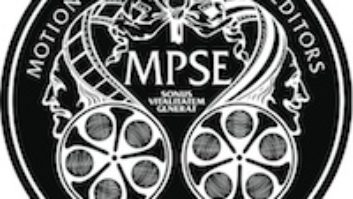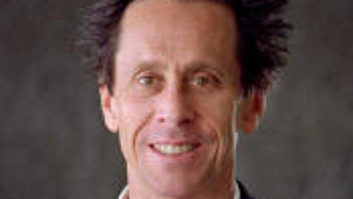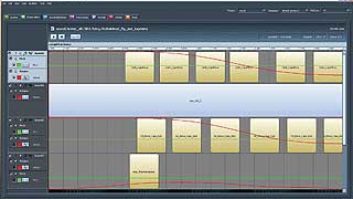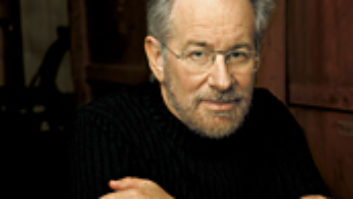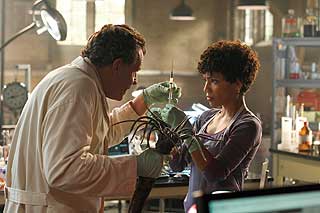
Fringe: John Noble plays Dr. Walter Bishop and Jasika Nicole plays Astrid Farnsworth.
” />
Just another day in the world of Fringe: John Noble plays Dr. Walter Bishop and Jasika Nicole plays Astrid Farnsworth.
Photos: Fox ©2010 Fox Broadcasting Co.
Parallel universes. Cryonics. Mind control. Clairvoyance. Mutations. Bald-headed Observers. What do these things sound like? Figuring that out and bringing them to life is the weekly challenge for the sound design team behind J.J. Abrams’ hit Fox series Fringe. The show focuses on a trio of FBI-led investigators who explore cases involving so-called “fringe science”—everything from the existence of a parallel universe (and the effects of getting from ours to theirs) to creepy, loathsome creatures (including humans) who attempt to wreak havoc on the unsuspecting.
For the show’s first season, the post-production sound was handled by a different team; for Season 2, Warner Bros. Television, seeking to use the convenience of a remote Pro Tools stage, set up a new team in a new office—upstairs from saucy Hustler Hollywood on the Sunset Strip—along with the writing and other post-production staff.
The new crew—comprising supervising sound editor Paul Curtis, re-recording mixers Rick Norman and Mark Hensley, and sound effects editor Bruce Tanis—inherited nothing from the previous team in terms of an SFX library. “Style-wise, it’s similar,” says Curtis. “But we’ve definitely added a different feel to the show.”
Curtis and team typically work within an extremely tight turnaround, sometimes spread over seven or eight days, but more often in the four- to five-day range. “This is a sprint to the finish—literally,” comments Norman.
To help get a jump on the process, editorial will pass along completed sequences that will likely require creating new SFX a few episodes in advance, allowing Tanis to begin developing those sounds as a pre-design prior to the formal spotting session. “They’re usually very specific to a device or a portal opening or an underwater sequence,” Curtis says. Upon receipt of the locked edit, Curtis will then take a pass spotting the episode before meeting with the picture editorial team, post supervisor, post coordinator and associate producers Tamara Isaac and Tanya M. Swerling.
“We’ll play Bruce’s pre-design, and ask them, ‘Of the elements we’ve given you, what do you like, what do you not like?’” Curtis explains. “We’ll go through and ask them what they’re looking for: ‘What is the idea of the storytelling at this point? What are we trying to convey?’ Sound should help with storytelling; it shouldn’t just be some big cool thing. It needs to help sell what they’re trying to sell, idea-wise.”
After spotting, the editorial process formally begins: Norman starts editing dialog, Curtis begins cueing and recording ADR, and after receiving spotting notes from Curtis, Bruce Tanis begins making adjustments and creating additional sound effects and background elements.
While Paul Curtis uses a Terabyte of basic library SFX to drop in small sound effects, the major sounds are created by Tanis, working either at the West Hollywood facility or at Warner Bros. (carrying sound and picture on a drive with him), sending finished cues to Curtis via the Internet as they’re completed.
As with its often-cited inspiration, The X-Files, Fringe is divided into two types of episodes: those referencing an ongoing “mythology” having to do with a parallel universe; and stand-alone episodes, featuring monster/science-of-the-week story lines. While stand-alone episodes contain sounds new to audiences each week, core mythology shows require re-creation of sounds that fans might be familiar with from previous episodes, which is particularly challenging in the absence of a Season 1 effects library.
“If we get a core mythology item—like the Observers’ [the mysterious bald characters who populate the mythology] gun or binoculars or the portal [between the two universes], we’ll reference last season’s episode to see what it sounded like and try to re-create that,” Tanis explains. The task is not always an easy one, Norman points out: “The editors will give us a show from last season, and say, ‘We want this device to sound like this.’ Of course, it’s comped in the track with music and other sounds so it can be tricky. It’s not identical, but it’s very close.”

Left to right: re-recording mixer Rick Norman, supervising sound editor Paul Curtis and sound effects editor Bruce Tanis in the Fringe post-production offices
Creating sounds for Fringe is a unique—and no doubt fun and creative—process. “Every show this season has had its single identifiable gimmicky sound thing that Bruce has had to design and come up with,” says Rick Norman. (These sounds often appear in the episode’s teaser.) The approach for those effects is consistent. “The mandate on the show,” says Tanis, “is that the tech sounds need to be sort of clunky, mechanical, not pristine ‘2001’ sounds,” befitting the show’s 1970s-era scientist character Walter Bishop. “It’s low-tech, high-tech sort of stuff,” Curtis adds. “It’s very low-tech, but it appears to be more high-tech. So it’s real clunky.”
Most sounds are for small, handheld gadget-type devices, though others—such as the portal to “the other side”—pose a bigger challenge. “The portal has several machines that turn on and combine together to make a field that opens a door to the other side,” Tanis explains. “And you go to the other side and you hear parts of it over there. The sound is built of many ongoing machines powering up, such as hospital machines—anything that has a weird kind of start to it. We’ll take it and treat it from there so that it’s nearly unrecognizable.”
That appears to be the second mandate, one which is common to all great sound effects: sounds that feel familiar to the viewer, though they can’t quite put their finger on what the source is. An example of that kind of effect was featured in the episode “Johari Window,” in which the Fringe team visit a small town, Edina City, fabled for its “Edina hum,” a frequency generated by a secret device that hides the deformities that the townsfolk all suffer, which are caused by the generator itself. The original direction for the sound of the Edina hum came from executive producer Jeff Pinkner. “We were in the dub here, and Jeff came in, and said, ‘Have you ever heard the 100-year locusts back east? That’s what I want it to sound like,’” recalls Paul Curtis. “So basically what we ended up with here were…bugs.”
Well, not just bugs. Tanis layered in a variety of machine sounds to complete the picture. “The characters are hearing the sound and visually referring to the sound, and you have to sell that with sound effects,” explains Norman. “You can’t have it be bugs or have it be mechanical.”
Adds Curtis, “We had two tracks of cicadas—one pitched down, one normal—and then there was another electrical, shock-y sound. So we had to play with the way they were mixed to make it feel like the hum. It’s one of those instances where we throw I-don’t-know-how-many things at it, and then finally say, ‘Okay, that’s what we’re looking for.’”
An episode’s signature sound—particularly one that spans an entire episode in the background—must be handled thoughtfully, says Tanis. “What’s weird about the Edina hum is that you hear it all over the town. It goes to the borders of this little town: indoors, outdoors, down the street, in the basement; you hear some level of it, but you don’t want to hear that for 44 minutes of a show. It’ll drive you nuts. So you have to blend it in, pick moments, bring it up, take it down, so that people can reference it, but you’re not listening to 44 minutes of hum.”
Foley, recorded at Warner Bros., will often help out with gore sounds, such as for Walter Bishop’s many autopsy sequences. For other sounds, such as for the subterranean “Mole Boy” monster in “Night of Desirable Objects,” the team will turn to group ADR actors to create vocalizations for creatures, whose work is then sometimes processed with library monster sounds. “For that show, we had one guy who would actually do a performance with half an orange in his mouth, creating a gargly nature that was perfect,” Curtis recalls.
“Things out of the library tend to have impact and weight and scary character, but they don’t have performance,” adds Tanis. “If you have your creature going through a scene and he needs to go from investigating something to full-on attack, it’s useful to have an ADR version to carry that arc in the character change. We can add growls or snarls under it to punctuate that.”
The Fringe team’s studio comprises a two-person Digidesign D-Control ICON control surface tied to a pair of higher-powered quad-core Macs: one for dealing with sound effects, and the other not only running dialog and music, but simultaneously re-recording the mix.
The system is linked directly to editorial’s Avid Unity editing system—located just down the hall—allowing for immediate access to changes to picture as opposed to the traditional waiting for a tape to be delivered, loaded and processed. “We’re not doing a traditional ‘record as you go’ mix,” says Norman. “This is a virtual mixing world we’re doing here. It’s a new business model for Warner Bros., having a high-powered remote mixing environment, and it’s proving to be successful.”
Matt Hurwitz is an L.A.-based freelance writer.


